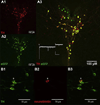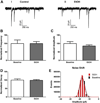Alcohol effects on synaptic transmission in periaqueductal gray dopamine neurons
- PMID: 23597415
- PMCID: PMC3950928
- DOI: 10.1016/j.alcohol.2013.02.002
Alcohol effects on synaptic transmission in periaqueductal gray dopamine neurons
Abstract
The role of dopamine (DA) signaling in regulating the rewarding properties of drugs, including alcohol, has been widely studied. The majority of these studies, however, have focused on the DA neurons located in the ventral tegmental area (VTA), and their projections to the nucleus accumbens. DA neurons within the ventral periaqueductal gray (vPAG) have been shown to regulate reward but little is known about the functional properties of these neurons, or how they are modified by drugs of abuse. This lack of knowledge is likely due to the highly heterogeneous cell composition of the vPAG, with both γ-aminobutyric acid (GABA) and glutamate neurons present in addition to DA neurons. In this study, we performed whole-cell recordings in a TH-eGFP transgenic mouse line to evaluate the properties of vPAG-DA neurons. Following this initial characterization, we examined how both acute and chronic alcohol exposure modify synaptic transmission onto vPAG-DA neurons. We found minimal effects of acute alcohol exposure on GABA transmission, but a robust enhancement of glutamatergic synaptic transmission in vPAG-DA. Consistent with this effect on excitatory transmission, we also found that alcohol caused an increase in firing rate. These data were in contrast to the effects of chronic intermittent alcohol exposure, which had no significant impact on either inhibitory or excitatory synaptic transmission on the vPAG-DA neurons. These data add to a growing body of literature that points to alcohol having both region-dependent and cell-type dependent effects on function.
Copyright © 2013 Elsevier Inc. All rights reserved.
Figures






Similar articles
-
Periaqueductal gray afferents synapse onto dopamine and GABA neurons in the rat ventral tegmental area.J Neurosci Res. 2010 Apr;88(5):981-91. doi: 10.1002/jnr.22265. J Neurosci Res. 2010. PMID: 19885830 Free PMC article.
-
Glutamate Transmission to Ventral Tegmental Area GABA Neurons Is Altered by Acute and Chronic Ethanol.Alcohol Clin Exp Res. 2018 Nov;42(11):2186-2195. doi: 10.1111/acer.13883. Epub 2018 Oct 3. Alcohol Clin Exp Res. 2018. PMID: 30204234 Free PMC article.
-
Moderate ethanol drinking is sufficient to alter Ventral Tegmental Area dopamine neurons activity via functional and structural remodeling of GABAergic transmission.Neuropharmacology. 2022 Feb 1;203:108883. doi: 10.1016/j.neuropharm.2021.108883. Epub 2021 Nov 13. Neuropharmacology. 2022. PMID: 34785165 Free PMC article.
-
Roles of dopamine and glutamate co-release in the nucleus accumbens in mediating the actions of drugs of abuse.FEBS J. 2021 Mar;288(5):1462-1474. doi: 10.1111/febs.15496. Epub 2020 Aug 11. FEBS J. 2021. PMID: 32702182 Free PMC article. Review.
-
The multilingual nature of dopamine neurons.Prog Brain Res. 2014;211:141-64. doi: 10.1016/B978-0-444-63425-2.00006-4. Prog Brain Res. 2014. PMID: 24968779 Free PMC article. Review.
Cited by
-
The Inferior Colliculus in Alcoholism and Beyond.Front Syst Neurosci. 2020 Dec 11;14:606345. doi: 10.3389/fnsys.2020.606345. eCollection 2020. Front Syst Neurosci. 2020. PMID: 33362482 Free PMC article. Review.
-
Structural and microstructral imaging of the brain in alcohol use disorders.Handb Clin Neurol. 2014;125:275-90. doi: 10.1016/B978-0-444-62619-6.00017-3. Handb Clin Neurol. 2014. PMID: 25307581 Free PMC article. Review.
-
Ionic currents influencing spontaneous firing and pacemaker frequency in dopamine neurons of the ventrolateral periaqueductal gray and dorsal raphe nucleus (vlPAG/DRN): A voltage-clamp and computational modelling study.J Comput Neurosci. 2017 Jun;42(3):275-305. doi: 10.1007/s10827-017-0641-0. Epub 2017 Apr 3. J Comput Neurosci. 2017. PMID: 28367595 Free PMC article.
-
The kappa opioid receptor modulates GABA neuron excitability and synaptic transmission in midbrainprojections from the insular cortex.Neuropharmacology. 2020 Mar 15;165:107831. doi: 10.1016/j.neuropharm.2019.107831. Epub 2019 Dec 21. Neuropharmacology. 2020. PMID: 31870854 Free PMC article.
-
Quantitative evaluation of extrinsic factors influencing electrical excitability in neuronal networks: Voltage Threshold Measurement Method (VTMM).Neural Regen Res. 2018 Jun;13(6):1026-1035. doi: 10.4103/1673-5374.233446. Neural Regen Res. 2018. PMID: 29926830 Free PMC article.
References
-
- Becker HC, Lopez MF. Increased ethanol drinking after repeated chronic ethanol exposure and withdrawal experience in C57BL/6 mice. Alcoholism: Clinical and Experimental Research. 2004;28:1829–1838. - PubMed
Publication types
MeSH terms
Substances
Grants and funding
LinkOut - more resources
Full Text Sources
Other Literature Sources
Molecular Biology Databases

